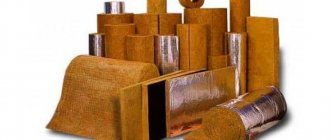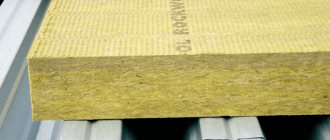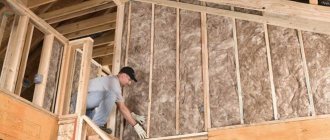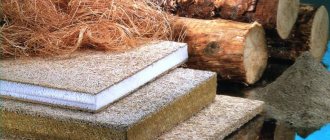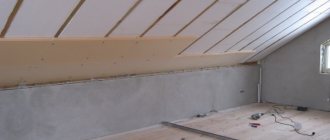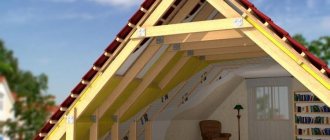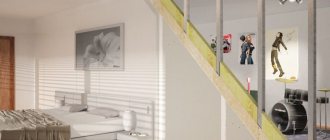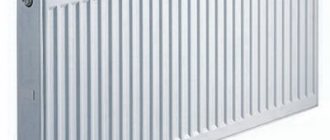Basalt insulation IZOVOL L-35. Photo source here
Manufacturing and trading enterprises produce and sell an extensive list of thermal insulation materials . Each variety has its own characteristics, advantages and disadvantages, which determine the scope of application. Basalt wool is a modern, high-quality and most popular material . The increased interest in basalt wool requires special consideration of this material. The article provides basic information; detailed information is collected in separate publications, links to which are included in the text.
What is it, composition
Basalt (alternative names: stone and mineral ) wool is pressed into different shapes, randomly intertwined fibers of mineral origin, hence one of the names. Externally, stone wool is a mass of needle-shaped fibers , the diameter of which is measured in microns, and the length is about 5 cm, the color is beige or gray . Rocks of the gabbro-basalt group and metamorphic rocks similar in chemical composition are used as raw materials for the production of materials:
- silicon dioxide (SiO2) - 45-65%;
- aluminum oxide (Al2O3) - 10-20%;
- calcium oxide (CaO) - 5-15%;
- magnesium oxide (MgO) - 5-10%;
- iron oxide (Fe2O3 + FeO) - 5-15%;
- sodium oxide + potassium oxide (Na2O + K2O) - 1-3%.
TeploKNAUF mineral wool for roofing. Photo Pilomaterialy.rf
There are three types of mineral fiber insulation, each of which has its own raw materials and production technology:
- glass wool produced from molten glass, as well as sand, soda, limestone, dolomite;
- slag wool made from melted blast furnace slag waste;
- basalt, produced mainly from the melt of basalt and gabbro rocks.
Binder
This insulation product always contains a binder. It binds the fibers and gives the desired density and shape. Types of binder:
— bitumen;
- synthetic, usually phenol-formaldehyde, phenol alcohols or urea resins.
- compositional (complex composition of several substances).
- bentonite clays.
Manufacturers most often use a composite binder. This is a synthetic composition that includes plasticizing and water-repellent additives, as well as phenol-formaldehyde resins. In the final material, formaldehyde and phenol are combined, and the binder is completely inert.
Production technology, how they make it
The process of making basalt wool is similar to the “work” of volcanoes , thanks to which this material was discovered. During the eruption of one of the volcanoes on the Hawaiian Islands, a strong flow of air turned lava (molten basalt) into strong and long threads. The local population found them and began to use them to insulate their own homes. Later the material was recreated under production conditions.
Basalt insulation Paroc eXtra Smart 50x600x1200 mm 7.2 sq.m. Photo Petrovich
Waste from the mining industry is used as raw material for the production of stone wool . The manufacturing process includes several stages:
- rocks are crushed to a powdery state;
- the mass is placed in an oven and heated to a temperature of 1500 degrees ; at this moment, the mass melts to the state of fibers, the formation process of which stops depending on the material of what rigidity needs to be obtained; if a manufacturer needs soft wool, then the fibers must be longer and thicker; for the production of semi-rigid and rigid slabs (this is the main form of production), then the fiber must be short and thick;
- the molten mass is fed to rotating drums , blown by a strong air stream, as a result of which the fibers cool and are fixed in a random order relative to each other;
- the fibers are cooled to a temperature of +200 degrees, binding components are added to the resulting mass, which are synthetic substances: formaldehyde or arbolo-urea resins, they fix the fibers, giving a clear structure;
- pressing fibers to a certain density level on a special conveyor belt;
- the material strip is cut into slabs or rolls;
- if necessary, the resulting products are reinforced or foil-coated.
Disadvantages of basalt insulation
Like any other heat insulator, basalt insulation has both its advantages and disadvantages. We have already talked about the advantages. Now it’s worth talking about the disadvantages of this material.
- Price is the most serious disadvantage of basalt insulation. Not everyone can afford this material. Although it is natural and quite durable. If you are determined to carry out insulation with such a heat insulator, you immediately need to prepare for large financial costs.
- When carrying out work using basalt insulation, small pieces may become exposed. This results in a column of basalt dust rising into the air. Inhaling it is not a very pleasant experience. This will definitely not have a positive effect on your health. Therefore, when carrying out work, it is necessary to wear a respirator as a safety measure.
- Although basalt insulation has high vapor permeability , its use in some cases is impractical. It is better to choose another one - for example, polystyrene foam, the price of which is higher. Stone wool is not suitable for work on insulating the basement or when the task arises of thermal insulation of the foundation of a house.
Properties and characteristics, advantages and disadvantages
The main properties and characteristics of basalt wool, which can also be classified as advantages, are:
- low thermal conductivity;
- resistance to open fire;
- high melting point (above 1100 degrees), as a result of which no harmful substances are released;
- hydrophobicity, the percentage of moisture absorption is 2%;
- vapor permeability, the indicator is 0.3 mg/(m*h*Pa);
- good sound insulation;
- light weight;
- strength, high peel and compressive strength;
- environmental friendliness;
- resistance to chemicals;
- durability, manufacturers indicate a service life of more than 50 years;
- the density is different, which allows you to choose the best option for solving various problems;
- ease of transportation, storage, installation;
- versatility.
Among the disadvantages of basalt wool, the high price should be noted; when cutting and laying, it is necessary to use personal protective equipment (goggles and a respirator), special clothing and gloves.
It is the wide list of positive characteristics and properties that makes stone insulation in demand.
Content
- Why do you need basalt insulation?
- Composition and principle of operation of basalt insulation
- Types of basalt insulation and scope
- Classification of basalt slabs
- Advantages of mineral wool
- Flaws
- Installation rules
- Basalt insulation Izover Master of warm walls
- Insulation for walls based on quartz Izover warm walls strong
Basalt mineral wool is used at construction and industrial sites to insulate façade elements, foundations, roofs, and floor coverings. The material is characterized by a low thermal conductivity coefficient, making it an effective insulator. For ease of use, stone wool is produced in the form of slabs, rolls and cylinders. Izover is the first and only manufacturer of both stone and quartz wool in Russia. Having full expertise in these matters, we will tell you about insulation based on basalt mineral wool.
Areas of application: for baths, etc.
The main area of application of basalt wool is construction: civil and industrial . In this industry, materials are used to insulate various structural elements of buildings : flat and pitched roofs, attic space, subfloors, interfloor ceilings, internal and external walls, including when installing multi-layer masonry, facades, ceilings, frame houses, foundations.
Thermal insulation of the pipe using basalt (stone) wool. Photo of SuperOven
Manufacturers provide specialized lines (products for baths and saunas are especially in demand) and universal materials . Stone wool can be found in water purification filters, pipeline transport and other fields of activity. Thus, basalt wool is used to solve a wide range of problems.
Harm
Is basalt wool harmful to health? At this time, despite the growing popularity of basalt insulation, we are increasingly talking about its harmfulness to the human body. Manufacturers of mineral wool point to its natural components, inertness and passivity to a variety of influences. But it is the connecting component that confuses opponents and helps competitors and opponents build negative arguments. The fact is that both formaldehyde and phenol are very toxic, even carcinogenic. Phenol formaldehyde resins can cause skin diseases. Of course, there are standards and regulations regarding the possible content of this compound in industrial materials, and the data stated in the certificates strictly comply with the requirements of current legislation. And yet basalt wool is harmful to health.
Kinds
To perform certain work, to insulate specific structural elements of buildings, it is necessary to use basalt wool with one or another set of properties. Basalt-based products are divided into several types according to individual characteristics.
Foil, with foil
Foil-coated basalt products are heat-resistant, waterproof materials, covered on one or both sides with thin aluminum foil. The products have heat-reflecting characteristics; slabs (or other forms of release) can be installed without vapor barrier. Foil materials are used to insulate walls, ceilings and partitions in baths and saunas. Features of stone wool with foil are:
- moisture-repellent properties , foil does not allow moisture and steam to penetrate inside the insulation, which increases its service life;
- increased efficiency , foil wool reflects thermal energy, preventing it from escaping through the walls, as a result, heat is retained in the room longer than when using standard materials;
- ease of installation , materials are installed with the foil side inward, joints are taped with aluminum tape.
Foil wool is also used for thermal insulation of household water supply and ventilation systems and pipelines. In industry, insulation is used to insulate technological equipment, elements of production lines, containers in which it is necessary to maintain certain temperatures, and refrigeration chambers. The products are actively used in frame construction.
In rolls, cylinders, mats and so on
The classification of basalt insulation is carried out in accordance with the form of release. Materials are produced in plates, rolls, cylinders, granules. The slabs, in turn, are soft, semi-rigid and hard. Rigidity determines the scope of application of products; the higher the indicator, the greater the mechanical loads the material can withstand.
Soft, with maximum insulating properties, not intended for significant impact, sold in mats and rolls. Semi-rigid ones are most often produced in slabs and cylinders, they are excellent for performing construction work for private and industrial purposes, suitable for insulating ventilated facades, protecting air ducts from fire in the event of a fire. Rigid ones can withstand heavy loads without deforming or losing their properties; they are produced in slabs and are intended for outdoor work and floor insulation.
Basalt insulation ISOBOX ExtraLight-31 in slabs. Stroylandia Photos
Rolls and slabs are in demand among private buyers. For large facilities, it is more practical to use granulated wool, which is blown into the walls with pneumatic devices, like ecowool. Cylindrical ones are used for working with pipelines and gas pipelines.
Dimensions
The dimensions of basalt products are indicated on the packaging - length x width x thickness. The most in demand are slabs whose standard dimensions are 1200x600 mm . Length indicators for slabs are 1000-1200 mm, width - 600, thickness - 20-240, materials with a thickness of 50 and 100 mm are in particular demand. Rolled cotton wool has the following average dimensions: length - 3000-10000 mm, width - 600-1200, thickness - 50-100. In addition to products of standard sizes, customers have the opportunity to purchase thermal insulation materials of non-standard dimensions.
Thickness: 50, 100 mm. and not only
The thickness of basalt insulation is an important parameter that directly influences the choice, since for solving various problems there are certain recommended values for the thickness of the thermal insulation layer. For example, to insulate sloping roofs, the value must be at least 150 mm, for external walls - over 100. To calculate the optimal value, you need to know two parameters:
- R – thermal resistance, measured in sq.m. per K/W;
- λB – thermal conductivity, which is indicated on the packaging, the average value is 0.45 W/sq.m x K.
Basalt insulation ROCKLIGHT-30, 50 mm thick. Stroylandia Photos
The indicators must be multiplied (R x λB), as a result it is possible to obtain optimal indicators for the thickness of the insulating layer for various structural elements, for example, for the roof it is 220 mm, for walls - 150 mm.
Izovol (Belgorod)
Izovol general construction and technical insulation is no different in structure from similar mineral wool from other brands. There are differences in technical characteristics. A unique production technology is used. Emphasis is placed on the use of environmentally friendly raw materials.
The list of options for traditional thermal insulation (ST, V, Isobel) is supplemented by mineral wool fireproofing (KV, F series) and soundproofing (Acoustic) materials. Recently, a combined insulation for a bathhouse was announced - mineral wool, laminated (a technique for joining dissimilar materials by pressing) with a thin aluminum sheet. Similar options are found in other manufacturers, but Belgorod innovators reinforced the reflective layer of their invention with fiberglass canvas.
The advantages of Izovol mineral wool are the geometric precision of the elements; ease of processing (with a knife, saw) regardless of density; acceptable cost. The disadvantages are dust (for all products) and phenols (true only for materials produced using old technologies).
The dustiness and toxicity of mineral wool is within international tolerances.
When working, use personal protective equipment; when installing indoors, prevent liquid from coming into contact with the material (a vapor barrier is required); outdoors, you will need a membrane that does not prevent moisture evaporation. Main characteristics of Izovol
| Izovol F-100 | Izovol KV-200 | Izovol Mat-50 | |
| Purpose | Thermal insulation of the facade | Insulation of the basement floor | Heat and sound insulation of premises |
| Dimensions, mm | 1 000х600х40-250 | 1 200х1 000х30-100 | 3,000-6,000x1,000x40-100 |
| Density, kg/m³ | 100 | 200 | 50 |
| Thermal conductivity, W/(m K) | 0.035 | 0.039 | 0.034 |
| Quantity per package(pieces/m²/m³) | Indicators depend on the dimensions of the material | ||
| Price, rub/m³ | 3 120 | 5 910 | 2 400 |
Video from the Isovol presentation:
Installation features: glue and everything you need
When performing installation yourself, you should be careful . When cutting cotton wool, particles are released into the air, which can enter the lungs, mucous membranes, and skin. Therefore, it is necessary to use protective equipment , goggles (or mask), respirator (or gauze bandage).
Depending on the type of work performed (which elements are insulated), the sequence differs. However, several general rules must be followed:
- installation should be carried out in dry weather at a temperature of +20...22 degrees;
- air humidity should not exceed 45%;
- It is recommended to cut the insulation with a knife (with a density of up to 80 kg/cub.m.) or a hacksaw (with a high density of the material).
The following is a brief summary of the isolation steps:
| Roofs: When insulating a roof, you should remember that the likelihood of condensation forming here is highest. Therefore, it is necessary to carry out work as follows: - a sheathing is formed from below the rafters, on which the insulation will be laid; — a vapor barrier film is laid overlapping over the sheathing; — joints are taped with tape or masking tape; — basalt products are laid on the film, to which a vapor barrier membrane for a pitched roof is attached with the smooth side; — the counter-lattice is stuffed; - boards are nailed to the rafters for fastening the roofing material; - roofing material is attached. If there is an attic under the roof, then OSB or plywood sheets should be attached to the bottom of the rafters. | Facade. There are several ways to arrange an insulating façade system. Insulation of a ventilated facade is carried out in stages: - a frame is formed on the wall, the distance between the vertical guides is 10-20 mm less. the width of the slabs, horizontal - 10-20 mm less. length, the width of the slats should be slightly greater than the thickness of the material to form a ventilation gap; — insulation is placed into the formed cells of the frame, the sheets of which are attached with dowels-fungi to the wall or staples to the frame; — a vapor barrier membrane is attached on top of the insulation; — a counter-lattice is formed; - the cladding is attached. “Wet method”, according to which basalt products are fixed to the wall using glue and special dowels, then a reinforcing mesh is attached to the wool, on top of which plaster is applied. Instructions for installing basalt wool are also included in the set of materials sold. Manufacturers offer detailed information to enable installation. |
| Walls: - the surface is cleaned of old finishes, and repairs are carried out if necessary; - a primer is applied; — a metal frame is mounted in increments the size of which is equal to the size (width) of the slab/mat; — insulation is laid between the vertical posts; — the cracks are filled with polyurethane foam; - drywall is attached to the frame. | Floors: - the base of the floor is prepared, repaired, all debris is removed; — waterproofing work is being carried out; — heat-insulating materials are laid, the seams are sealed with tape or tape; — a reinforcing film is laid on top of the insulation; — the screed is poured. |
The best manufacturers
According to the ratings, the products of the following manufacturers are in high demand:
- ROCKWOOL (Denmark) is a company with a wide network of representative offices and factories, which allows it to offer materials of European quality at fairly reasonable prices;
- Paroc (Finland) - thermal insulation materials provide excellent sound and noise absorption;
- TechnoNIKOL (Russia) - products are of good quality and affordable;
- ISOVER (France) is a leader in many countries of the world; its products have an optimal price-quality ratio.
Rockwool insulation Rockfacade 100x600x1000 mm 1.2 sq.m. Photo Petrovich
This is not a complete list of large and well-known brands.
Beltep (Belarus: Gomel)
Until 2007, the Belarusian enterprise Gomelstroymaterialy worked with varying efficiency and mainly for the domestic market. The popularity of high-quality and relatively inexpensive materials has become an incentive to develop a network of trading houses in the Republic of Belarus and to search for dealers outside the republic. Thus, almost 10 years ago Beltep mineral wool appeared on the construction market of the Russian Federation.
Small assortment:
- for roofing (RUF);
- for external walls (Vent, Facade)
- for internal walls and partitions (Light)
- on the floor and ceilings (Flor).
In the total mass of the main groups, there are 20 brands of mineral wool insulation. But interest in the products is actively maintained by updating the product list. Today these are materials with an impressive range of data on the main characteristics.
Pros: large selection of sizes, stable quality of each batch.
Disadvantages: low elasticity and a lot of dust during installation.
Main characteristics of Beltep
| Light Extra | Ecolight | Station wagon | |
| Purpose | Insulation of roofs and facade systems | Thermal insulation of walls and ceilings indoors | Construction and technical insulation |
| Dimensions, mm | 1,000-1,200x500,600,1,000x100-150-200 | 1,000-1,200x500,600,1,000x40-200 | 1,000-1,200x500,600,1,000x30-200 |
| Density, kg/m³ | 25 (±5) | 50 (-10, +5) | 60 (-5, +10) |
| Thermal conductivity, W/(m K) | 0.032 | 0.04 | 0.036 |
| Quantity per package(pieces/m²/m³) | The configuration, area and volume depend on the combination of dimensions for a unit of material | ||
| Price, rub/m³ | 1 460 | 1 600 | 1 880 |
Video about the manufacturer Beltep:
Which one is better to choose?
Basalt insulation ISOVER Frame house. photo source here
First, before purchasing insulation, you should decide on several initial data:
- which structural element is to be insulated , then choose either a material specially designed for this work, or pay attention to universal products;
- budget calculation , high-quality products from leading enterprises are sold at appropriate prices, basalt products of well-known brands should be purchased from trusted suppliers in order to minimize the likelihood of purchasing a counterfeit;
- necessary characteristics , the most important parameters when choosing are thickness, dimensions and density, the first two were discussed earlier, so some recommendations on the third parameter should be noted: insulation with a density of up to 35 kg/cub.m. It is recommended to use for heat and sound insulation of non-load-bearing pitched roofs, attics and attics, for insulation of frame walls and ceilings;
- 35-50 — for insulation of ventilated facades and external walls of low-rise buildings;
- 50-75 — for insulation of floors, concrete and wooden ceilings, in multi-layer internal partitions;
- 75-100 — for insulation of external walls;
- 100-125 — for insulation of reinforced concrete structures;
- 125-150 — increasing the sound insulation properties of floors and walls;
- over 150 - for screeded floors.
For convenience, you should decide on several lines of materials suitable for their characteristics, from which you need to choose the best option.
Knauf (Stupino, Tyumen)
Knauf has managed to combine the high vapor permeability of glass wool (previously the main product) with the low water absorption and thermal conductivity of mineral wool material.
Each of the thermal insulation options in the innovative Knauf Insulation line is designed to solve specific problems:
- Knauf Insulation Facade - for insulating walls under ventilated facades and plaster.
- Knauf Insulation Pitched Roof - for thermal insulation of pitched roofs and attic floors.
- Knauf Insulation Acoustic Partition – for effective sound absorption.
High profitability with this material is possible when insulating large areas, such as production or retail sites. When building a private house and apartment, you will pay a little more than for conventional material, but you will receive reliably insulated surfaces.
Pros - declared environmental friendliness, due to the absence of a phenol-formaldehyde binder and packaging (a single package reduces the volume of material by half, a multipack - 8 times).
The downside is the modest size range and price.
Main characteristics of Knauf Insulation
| Knauf Insulation Facade Thermo Plate 032A | Knauf Insulation Pitched Roof Thermo Roll 037 | Knauf Insulation Acoustic Partition | |
| Purpose | Thermal insulation of ventilated facades | Reducing heat loss in the attic floor | Soundproofing rooms |
| Dimensions, mm | 1 250x600x100 | 9 000х1 200х50 | 1 250x610x50 |
| Density, kg/m³ | 34 | 25 | 15 |
| Thermal conductivity, W/(m K) | 0.032 | 0.041 | 0.37 |
| Quantity per package(pieces/m²/m³) | 5 / 3.75 / 0.375 | 2/ 12.2 / 0.61 | 24 / 18.3 / 0.915 |
| Price, rub/m³ | 2 133 | 1 388 | 1 282 |
Review of Knauf insulation. The author of the video showed what happened to the insulation after it was set on fire and rolled with a forklift:
Where can I buy
You can get acquainted with the range of materials offered for sale on the websites of companies that are listed in the corresponding section. Enterprises sell an extensive range of thermal insulating basalt products to solve a wide range of problems.
Basalt wool · 12/22/2020 · 0
